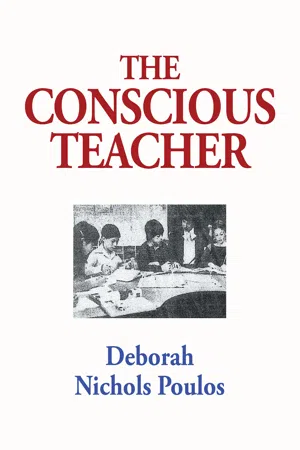
- 368 pages
- English
- ePUB (mobile friendly)
- Available on iOS & Android
The Conscious Teacher
About This Book
The Conscious TeacherBy Deborah Nichols Poulos The Conscious Teacher is about all kinds of strategies and techniques educators might employ to become more effective teachers. In an accessible, conversational style, Deborah Nichols Poulos presents unique approaches to teaching that will inspire new and veteran teachers alike.She begins with her personal story of not being able to read all through elementary school. Her early failures convinced her she was dumb. At first, she struggled, but when she still failed, she adopted an avoidance strategy that served her well until junior high. An experience in the seventh grade flipped a switch and started her on a journey to becoming an outstanding student and, later, to applying the lessons she learned as a child to her own teachingWhat makes The Conscious Teacher unique are the inspirational lessons that are unlike what most teachers get in their teacher-education courses or student teaching. Ms. Nichols Poulos points out, for example, that from the very first day, it is important that students learn they will be treated with dignity and respect no matter what. And especially helpful are the steps Ms. Nichols Poulos employs to set up a behavior management plan that works. She explains the strategic steps she takes before school starts—how essential it is to get to know each student before they walk into class on that first day. She also illustrates how setting up classroom routines helps students know what to expect and how to make the best use of every minute. And she emphasizes the importance of the parent-student-teacher team and includes many examples of how to communicate with—and involve—parents, even those who may be difficult.Foundational to her program are reading and writing. Among other things, she lays out the steps for students—even as early as fourth grade—to write five paragraph essays and their own student-authored books, and to research and write reports that include bibliographies. When she differentiated curriculum to support all students' needs, she found their learning accelerated. All teachers will appreciate her ideas about how to teach the basics of math, as well as advanced math concepts. And her ideas for teaching the arts are inspirational, as she describes in detail how her fourth graders performed Shakespeare's Hamlet, Macbeth, King Lear, Julius Caesar, and A Midsummer Night's Dream. She also shows how to integrate social studies with literature and writing. Her experiences taught her that young students are much more capable than many people realize.The Conscious Teacher is an indispensable guide for all new teachers. Many of the ideas Ms. Nichols Poulos provides will also be an eye-opener for parents and experienced teachers as well. The Conscious Teacher is simply a must have for anyone truly interested in giving young children a positive and solid foundation for their later schooling.
Frequently asked questions
Information
- Does she lead through the power of her authority?
- Does she intimidate and threaten?
- Does she raise her voice and display anger?
- Does she establish reasonable behavioral ground rules and then repeatedly reinforce them through teaching strategies that model respect?
- Does she always maintain an affect of calm and support?
- Does she demonstrate an attitude of mutual respect?
Table of contents
- Dedication
- Foreword
- Preface
- Acknowledgements
- Introduction
- My Own Story
- On Not Being Able to Do Math
- College
- Life after College
- My Education and Teaching Experience
- Before You Decide to Become a Teacher… …You should realize that teaching is a time-consuming career
- How to Get the Job You Want: Consider Substitute Teaching
- First Things First: Set the Stage for Effective Learning
- Instruction in the Classroom
- Teaching Gifted Students